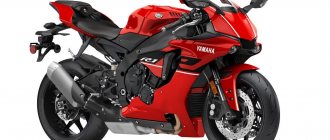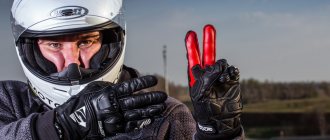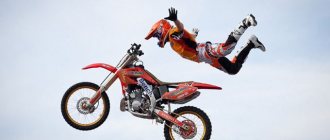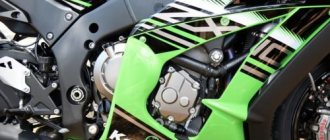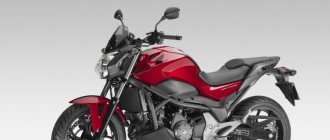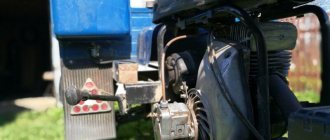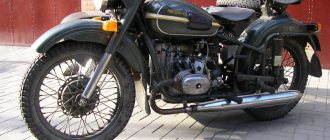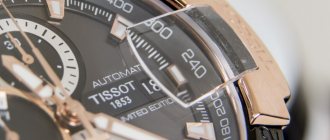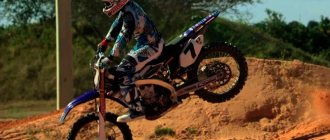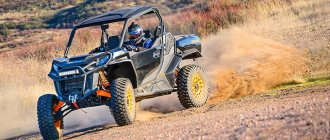No matter how much I studied on my own and took private lessons, my head was constantly a mess of disparate knowledge. Anton and Denis put everything in its place from the very first lessons. The first turn after the start line was, frankly speaking, not successful for me before. Now this is one of my favorite places on the track. Good acceleration, sharp braking to the apex while leaning, and almost full throttle - now this is the only way! The S began to turn out much better when I realized that between apexes I had to go at a steady “throttle”, and not “open” and, as a result, fly out strongly. I still get jittery before a pseudo 90-degree turn. There is always someone falling and trying to take me with them.
The Motoexpert magazine, based at the Anton Bezshlyaga Academy of Motorsports, begins a series of educational articles devoted to the theoretical foundations of road-circuit motorcycle racing. Experienced instructors Anton Bezshlyaga and Denis Yadak will share subtleties and secrets with you. Mikhail Pimus, who completed the basic practical course at the academy, will talk about his successes and achievements. As a clear example, the newly opened everyone’s favorite karting track “Leader” will be used.
A whole bunch of essentially good books have been written on circuit racing. But even if you read them all carefully, you most likely won’t learn anything. Do you know why? There is simply nowhere to apply this knowledge, and some of it is completely outdated. Theory without practice in a specific case will lead to nothing. Each line read separately must be immediately felt in action. Knowledge must be layered and adjusted over and over again. Only then will there be a result.
We will specifically give you information with a very close connection to the “Leader”. It’s easier to learn from ready-made examples. Under our dictation, you can do as much practice as you need. Comparing your feelings and our explanations, if you have a certain perseverance, good equipment and properly prepared equipment, after studying the Leader karting track, you will subsequently be able to independently master any other track. It's never too late to start learning. The more track riding techniques you master, the more free you will feel on a motorcycle. Including when driving around the city.
The publication plan is approximately as follows. In the next two materials we will look in detail at how to properly drive a lap on the Leader karting track. Then we will take a closer look at trajectory construction, braking, taxiing, landing, winter preparation and some other important aspects.
The standard of minimalism
Let's look at the list of attachments that, we assure you, you don't need at all (you can keep them in the garage until better times - it will be more intact). Mirrors. The most dangerous attribute of a modern motorcycle. Let's say you're throwing all your money away, and suddenly a more experienced and faster pilot overtakes you. God forbid at this moment to look in the mirror and see a rapidly approaching opponent! At a minimum, you are guaranteed to be scared and lose concentration for a moment. This may be enough to send you into the gravel. The worst thing you can do is mechanically “give way” to him, thereby behaving unpredictably for the overtaking person. This is the most common mistake made by beginners, so the first requirement before going to the track is to remove the mirrors from the motorcycle or fold it so that it is impossible to look into them.
Lighting engineering.
A headlight, brake light, turn indicators are dangerous in the event of a fall, when all this glass-plastic splendor breaks, breaks into pieces and turns into a damaging element for those who are driving behind: a cut on a tire or a puncture of a cooling radiator by a splinter is the least of evils, and Now, if someone falls on this “mess”... The second thing is the visual effect. Reflexes developed over years of driving on city streets also work on the track: an overtaking person can unconsciously fix his gaze on the brake light, the “Golden Rule” will work: where you look, there you go. You could simply be hit by a pilot who was staring at your brake light. And it costs a lot to break. Plus, you can lighten the motorcycle by 7-10 kg!
Standard plastic.
Its main inconvenience is the price. One detail of the cladding is comparable to buying a sports kit. The second inconvenience is the method of fastening and the number of parts. The standard cladding contains 6-9 pieces with threaded and clip fasteners. The sports version has 4-5 large elements on quick-release fasteners. Definitely remove standard plastic! Together with the standard plastic, we remove the seat - driver and passenger.
What else can you remove?
Cooling fans. It is impossible to drive in city traffic jams without them. But in track conditions, where the radiator is constantly blown, the fan, on the contrary, adds 5-8 degrees to the engine temperature! If you don't plan to ride a motorcycle to and from the track, you need to take it off. We also remove unused control panels (after all, we no longer have turn signals and headlights) and a sound signal. You can remove the side support (immediately minus 600 g), but only if you have already acquired a stand and learned how to put a motorcycle on it alone. Here we have a suitable blank for building a track motorcycle of any level. Next, we’ll look at what needs to be changed/added to make the motorcycle more competitive. [nxtpage]
Features and Rules
In fact, road racing (or simply GCR) is not exactly a discipline, but rather a separate area, including several types of racing and being the complete opposite of off-road competitions. In this case, all events take place on specially organized asphalt loop tracks. Unlike a speedway, where the main emphasis is also on speed, tracks for the GCS are longer (at least 3 km) and have a complex shape, including not only straight lines, where motorcycles can reach maximum speed, but also a large number of turns.
The duration of the race is usually stated in the number of laps and depends on the class of motorcycles participating. In any case, the start takes place simultaneously from the starting grid, which places the participants in a checkerboard pattern. Starting positions are determined by completing a qualifying lap (or laps) against the clock. If two qualifying laps are completed, the minimum lap time will be counted.
The finish of the race is announced when the first participant who has completed the number of laps specified by the competition rules crosses the finish line. From this point on, the remaining participants complete the last lap and finish. A participant who managed to cover more than 75% of the total distance and cross the finish line no later than 5 minutes after the leader is considered to have completed the race.
The distribution of points as a result of each race is made in accordance with the scale specified in the rules. In most cases it looks like this:
| Position | 1 | 2 | 3 | 4 | 5 | 6 | 7 | 8 | 9 | 10 | 11 | 12 | 13 | 14 | 15 |
| Glasses | 25 | 20 | 16 | 13 | 11 | 10 | 9 | 8 | 7 | 6 | 5 | 4 | 3 | 2 | 1 |
If a race consists of a series of stages, the final results are obtained by adding up the results of each stage.
From simple to complex
Track motorcycles can be divided into 4 levels of training: 1. “I want to try”;
2. “Athletic”; 3. "Superstock"; 4. "Supersport". Let's start building our “virtual” motorcycle with the simplest thing - “I want to try.” This option is suitable for those who want to understand whether they need it or not. In the beginning was the word? No - brakes! There is nothing easier than unscrewing the handle “for 250 km/h.” But stopping it from such a speed safely and in the shortest possible distance is not an easy task. The first thing that needs to be improved is the brake system. Brake hoses must be replaced immediately. Reinforced hoses provide excellent feedback and linear transfer of braking force from the master to the slave cylinders and weigh less than standard ones. We recommend not to get creative and not assemble the hoses yourself. Ready-made hose sets for a specific motorcycle model from Goodrige, Hel, TRW-Lucas and Galfer can be purchased “in stock” for a long time. The next step is to install sports brake pads. The friction material of standard pads has very good friction properties, but standard pads are not designed for racing temperatures. We install pads that can withstand overheating without changing the properties of the friction clutch or burning. Our choice is hoses and pads from the German TRW-Lucas: these are the best quality offers on the market now!
While our motorcycle is “undressed”, it needs to be dressed up in sports plastic. There is nothing complicated about this: kits can be purchased from sports teams. Of course, all manufacturers make it from different materials and using different matrices. We install Czech Sebimoto on the Honda CBR600RR. There is nothing special about the installation, but if you are not confident in your abilities, it is better to contact those who do this all the time.
The motorcycle is ready for “testing the pen”! Nothing superfluous, as well as additional sports equipment. We boldly go to the track, be it Myachkovo, Kazan or our favorite motor racing track in Brno! So, you have successfully completed several trial workouts. If after this you decide that you don’t need a track and that “traffic light races” with four-wheelers are more interesting, you will face the tedious process of reassembling a “city” motorcycle. If you have realized the danger of pseudo-sporty driving around the city, then we are on the same path and let’s build a motorcycle for an “athlete”! At this level there are no restrictions on modifying the motorcycle at all. If you are not going to participate in the Russian Championship, then the technical regulations do not limit your imagination. Typically, training in “amateur” classes is based on common sense and the needs of the pilot. The motorcycle is already equipped with: reinforced brake hoses, good brake pads and sports plastics.
Surely, while you were driving to understand “how it is in general”, you noticed that no matter how much you twist the throttle, many fly past or simply drive away from the turn “to the point”. What helps you accelerate so quickly? More powerful motor!? Deep engine tuning in lower classes is prohibited everywhere, and installing a Power Commander, even in combination with a full exhaust system, is not capable of providing such a noticeable advantage. The answer is final gearing, that is, the gear ratio between the driving and driven stars. In modern motorcycle construction, the “standard” gear ratio is considered to be 2.6 (read: front sprocket 16, rear sprocket 42). There are no standards in sports. On the same track, different drivers can use gear ratios from 3.2 to 2.8. But, as a rule, everyone starts with “3” (front 15, rear 45). So we'll buy some stars; we'll also need a longer chain. At the same time, we’ll make it easier too! 98% of the bikes on the track use the 520 type chain. On 1000 cc motorcycles - reinforced “520”, Extra Heavy Duty. We select the length of the new chain based on which stars we are going to use. On the HONDA CBR600RR, for rear sprockets 43-48, it is enough to install two additional links. The database contains 112, we buy 114. Be careful! The motorcycle will begin to respond much more aggressively to turning the throttle! You must understand that replacing the sprockets does not make your engine more powerful, but it increases the torque at the rear wheel, which allows you to accelerate the motorcycle more intensely. You can buy several different sets at once to change the gear ratio as your skills increase or for different tracks.
We taught the motorcycle to accelerate and brake. But for confident control you need more. Next on the list are tires! This is the main component that significantly increases the coefficient of adhesion to asphalt. Sports tires are almost never supplied to Russia due to problems with customs, certification and other nonsense. It’s worth looking in the same teams that regularly travel to Europe for training. You can buy good used options, of quite high quality and at very reasonable prices. All well-known brands are represented on the sports market, but if you do not have wheel warmers, then our recommendation is Pirelli or Metzeller. Some of the best tires are Dunlop, but when not warmed up they are hard and slippery, which is simply dangerous on the track! Slick tires (tires without tread) have the highest coefficient of grip and are cheaper than slick tires. But remember that slicks are not allowed for racing on 600cc motorcycles. In principle, you can stop there: stock up on several sets of tires and train for your own pleasure. But, as we have already said, if you are not going to the Russian Championship, tuning can not be limited. We classified further modifications as “Superstock”. [nxtpage]
reference Information
Karting track "Leader" is located at the address: Russia, Moscow region, Podolsk, 41st km of Simferopol highway, territory of the Ivanhoe country club. The track was designed and built in 2004 to host competitions for the Russian Karting Championship. The official opening took place in July 2005. In 2013, the karting track was temporarily closed and reopened in May 2016. The track configuration is most conducive to karting, supermoto and minimoto. Ring people view “Leader” more as a training ground. The length of the track is 1153 m, the maximum width is 10 m, the minimum width is 8 m, the number of turns is 17 (eight left, nine right). There is a stand for 1000 people, a timing system, a cafe, toilets, and parking. The current price for renting a track is 400 rubles for a 15-minute session, 2000 rubles for a track day.

